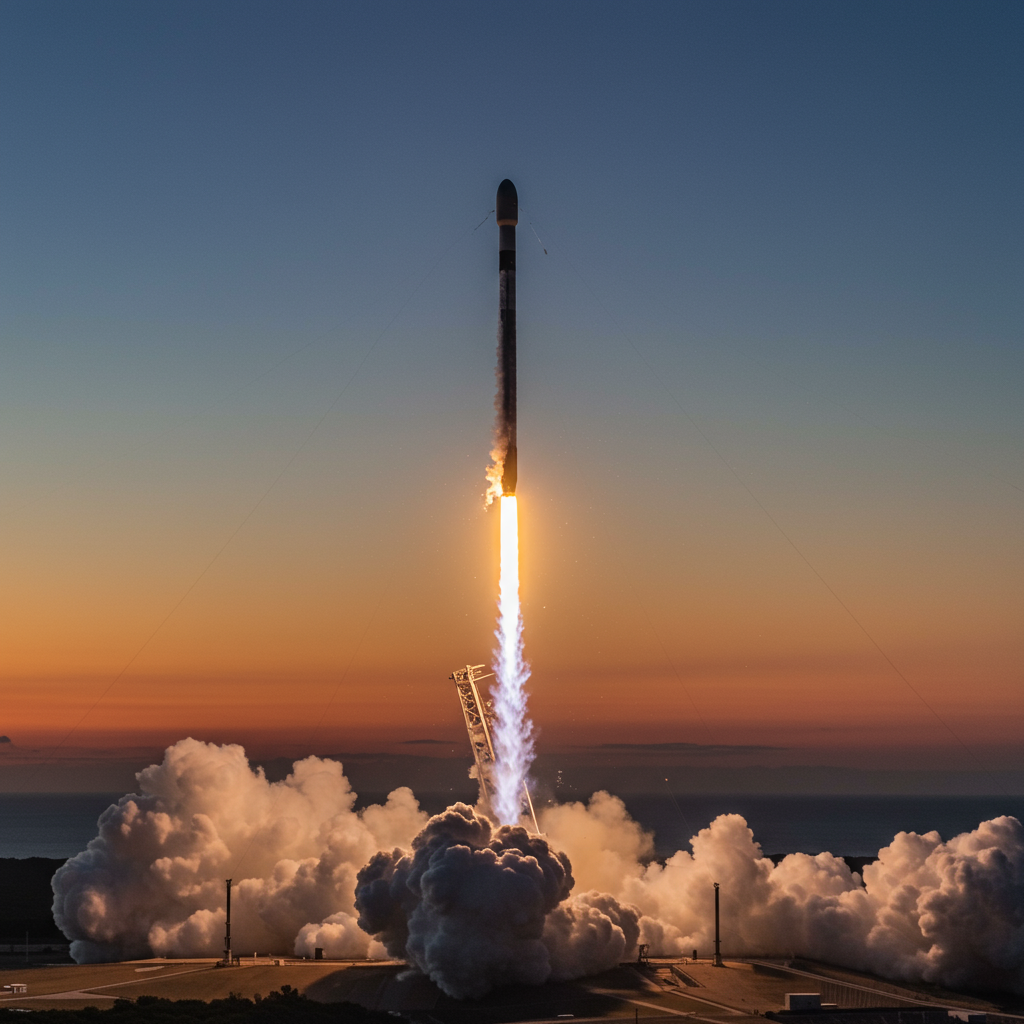SpaceX is poised to achieve another monumental milestone with the SpaceX Falcon 9 Kuiper launch scheduled for Friday, August 8. This mission will send 24 of Amazon’s Project Kuiper internet satellites into orbit. It marks SpaceX’s 100th mission of the year, showcasing the company’s incredible operational tempo.
Tune in live as the Falcon 9 rocket lifts off from Florida’s Cape Canaveral Space Force Station. The launch window opens at 9:40 a.m. EDT (1340 GMT). This critical launch was previously delayed from August 7 for additional pre-flight checks, underscoring SpaceX’s commitment to mission safety and success.
The Mission: Powering Project Kuiper’s Global Ambition
This upcoming SpaceX Falcon 9 Kuiper launch is a pivotal step for Amazon’s ambitious Project Kuiper, a burgeoning low Earth orbit (LEO) constellation designed to deliver high-speed, affordable internet connectivity worldwide. While still in its early stages, Kuiper aims to rival established players in the satellite internet sector.
Project Kuiper’s Vision Takes Flight
Amazon’s Project Kuiper is envisioned to eventually comprise over 3,200 spacecraft. The current launch will bring the total number of Kuiper satellites in orbit to 102. This is only the fourth dedicated Kuiper liftoff to date. Achieving its full constellation size will require more than 80 launches over the next few years.
To accomplish this massive deployment, Amazon has secured agreements with a diverse array of launch providers. Besides SpaceX’s reliable Falcon 9, Project Kuiper satellites are slated to ride on Arianespace’s Ariane 6, Blue Origin’s New Glenn, and United Launch Alliance’s Atlas V and Vulcan Centaur rockets. This multi-provider strategy highlights the scale and urgency of Amazon’s LEO internet goals.
Beyond Starlink: A Growing Satellite Internet Ecosystem
Project Kuiper stands as a direct competitor to SpaceX’s own Starlink broadband megaconstellation. Starlink currently boasts over 8,100 operational satellites, providing internet access to millions globally. More than 70% of SpaceX’s Falcon 9 launches this year have been dedicated to expanding the Starlink network, demonstrating the rapid buildout of this LEO giant.
The satellite internet landscape is dynamic and rapidly expanding. Beyond Starlink and Kuiper, companies like OneWeb (now part of Eutelsat Group) are also building out their constellations. SpaceX itself played a crucial role in OneWeb’s completion, stepping in as a launch provider after OneWeb faced geopolitical challenges with its prior Soyuz rocket agreements. This illustrates SpaceX’s critical position as a go-to launch partner for various LEO constellations.
SpaceX’s Unprecedented Cadence: A Year of Records
This particular mission is a landmark for SpaceX, marking its 100th mission of the year in 2025. This impressive figure includes both orbital launches and crucial suborbital test flights of its next-generation Starship vehicle, designed for human exploration of Mars.
A Pace Unmatched in Space History
SpaceX continues to set new benchmarks for launch frequency. If the company maintains its current pace, it is projected to complete approximately 165 missions by the end of 2025. This would significantly surpass its previous single-year record of 138 missions, achieved in 2024. That 2024 record included 132 Falcon 9 liftoffs, two Falcon Heavy launches, and four Starship test flights.
In October 2024 alone, SpaceX achieved its 400th overall orbital launch, followed by its 400th Falcon 9 flight in November. The year 2024 concluded with an astounding 134 orbital launches for SpaceX, solidifying its dominant position in the global launch market. For context, the entire world saw 259 orbital missions in 2024, with U.S. launch sites accounting for 54% of this traffic. SpaceX was responsible for over 2,300 payloads that year, representing an incredible 85% of the global total.
The Power of Reusability: A New Booster Takes Flight
The SpaceX Falcon 9 Kuiper launch also highlights the company’s pioneering efforts in rocket reusability. Following liftoff, the Falcon 9’s first stage is programmed to perform a precision return to Earth, targeting a touchdown on the drone ship “A Shortfall of Gravitas” in the Atlantic Ocean. This landing is expected roughly 8.5 minutes after launch.
Interestingly, this specific Falcon 9 booster will be making its debut flight. While SpaceX is renowned for reusing its rockets, with its most-flown Falcon 9 having completed 29 flights, a brand-new booster for a mission is becoming increasingly rare. This indicates a continued commitment to expanding their fleet while maintaining their high cadence. This reusability model significantly reduces launch costs and enables the rapid turnaround times SpaceX is known for. The company expects to soon see a single booster exceed 25 flights and achieve its 400th successful recovery of a Falcon first stage.
Beyond Commercial Satellites: Diverse Missions
SpaceX’s operational portfolio extends far beyond commercial internet satellites. The company also supports critical national security missions and deep-space exploration. In October 2024, a Falcon Heavy rocket, SpaceX’s third operational rocket type, launched NASA’s Europa Clipper probe towards the Jupiter system.
Furthermore, SpaceX is a key partner for the National Reconnaissance Office (NRO), deploying classified payloads for the U.S. government’s “proliferated architecture.” These missions, often utilizing Starshield (a government-focused variant of Starlink technology), aim to enhance resilience and provide faster, more diverse intelligence data. This strategic partnership underscores SpaceX’s versatile capabilities and its role in bolstering national defense.
Watching the Launch Live
SpaceX will provide a live stream of the SpaceX Falcon 9 Kuiper launch via its official website and its account on X (formerly Twitter). Coverage typically begins about 15 minutes before the scheduled liftoff. Be sure to mark your calendars for Friday, August 8, at 9:40 a.m. EDT to witness this significant event.
Frequently Asked Questions
What is the significance of this SpaceX Falcon 9 Kuiper launch?
This SpaceX Falcon 9 Kuiper launch is highly significant for multiple reasons. It marks SpaceX’s 100th mission of the year in 2025, demonstrating the company’s unprecedented launch cadence and operational reliability. For Amazon, it’s a crucial step in building out its Project Kuiper internet satellite constellation, directly competing with SpaceX’s own Starlink. This launch adds 24 satellites to Kuiper’s nascent network, pushing the total to 102 and accelerating Amazon’s goal of global internet connectivity.
Where can I watch the Falcon 9 launch of Amazon’s Kuiper satellites live?
You can watch the SpaceX Falcon 9 Kuiper launch live through official channels. SpaceX typically provides a free live stream on its official website (SpaceX.com) and its account on X (formerly Twitter). The broadcast usually begins approximately 15 minutes before the scheduled liftoff. The launch window opens at 9:40 a.m. EDT (1340 GMT) on Friday, August 8, from Cape Canaveral Space Force Station.
How does Amazon’s Project Kuiper compare to SpaceX’s Starlink?
Both Amazon Project Kuiper and SpaceX Starlink are ambitious LEO constellation projects aiming to provide global broadband internet. Starlink is currently far more established, with over 8,100 operational satellites and a massive customer base. Project Kuiper is in its early buildout phase, aiming for 3,200 satellites eventually, compared to Starlink’s tens of thousands. While Starlink primarily uses SpaceX’s Falcon 9, Project Kuiper plans to diversify its launch providers, using rockets from SpaceX, Blue Origin, ULA, and Arianespace to achieve its deployment goals.
The SpaceX Falcon 9 Kuiper launch on August 8 is more than just another rocket launch; it’s a testament to the rapid advancements in space technology and the burgeoning competition in the satellite internet sector. With SpaceX consistently pushing the boundaries of launch frequency and reusability, and Amazon aggressively building out its Kuiper constellation, the future of global connectivity from space looks brighter than ever. Witnessing this 100th mission of the year solidifies SpaceX’s position as a driving force in the new space age.




